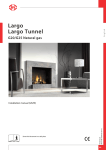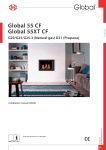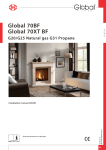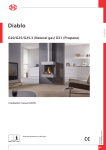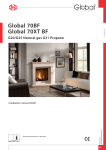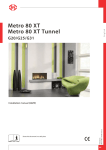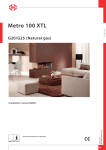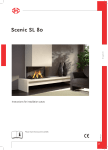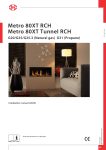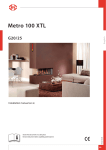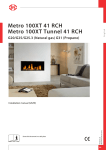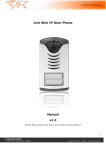Download Installation manual - Dru site for the trade
Transcript
English Global 100 BF-03 G20/G25/G25.3 (Natural gas) G31 (Propane) 38P-0574 Store this document in a safe place 959.095.01.UK DRU-677093-EN-US-1115-2 Installation manual (UK/IE) UK INSTAL L ATIO N MA N U A L Contents English 1. Introduction 2. CE declaration 3. SAFETY 3.1 General 3.2 Regulations 3.3 Precautions/safety instructions during installation 3.4 Second thermocouple safety 3.5 Oxypilot safety 4. Removing the packaging 5. Installation 5.1 Type of gas 5.1.1 Reconstruction to different type of gas 5.2 Connection 5.2.1 Gas connection 5.2.2 Electric connection 5.3 Placing the appliance 5.4 Placing a built-in appliance 5.5 Placing the chimney breast 5.6 Placing the control hatch 5.7 Flue gas discharge system in appliances with open combustion 5.7.1 General 5.7.2 Connection flue gas discharge system 5.8 Flue gas discharge / combustion air supply system in appliances with closed combustion 5.8.1 General 5.8.2 Construction of the concentric system 5.8.3 Placing the concentric system 5.8.4 Connection existing chimney 5.9 Additional instructions 5.10 Glass pane 5.11 Setting the appliance 5.12 Placing the wood, pebble and broken glass sets 6. Control 6.1 Connecting the receiver 6.1.1 Connecting the receiver 6.1.2 Placing / replacing the receiver's batteries 6.2 Setting the communication code 6.3 Alternative operation 7. Final inspection 7.1 Gastightness 7.2 Gas pressure/line-pressure 7.3 Ignition pilot and main burner 7.3.1 First ignition of the appliance after installation or adjustments 7.3.2 Main burner 7.4 Flame picture 8. Maintenance 8.1 Parts 9. Delivery 10. Malfunctions Appendix 1 Diagnosis of malfunctions Appendix 2 Various tables Appendix 3 Figures UK INST AL L AT I ON M AN U A L 1. Introduction English DRU, a manufacturer of gas-fired heating appliances, develops and produces products that comply with the highest quality, performance and safety requirements. This appliance has a CE label, which means that it complies with the essential requirements of the European gas appliance directive. The appliance is supplied with an installation manual and a user manual. As an installer, you must be certified and competent in the field of gas-fired heating. The installation manual will give you the information you need to install the appliance in such a way that it will operate properly and safely. This manual discusses the installation of the appliance and the regulations that apply to the installation. In addition, you will find the appliance’s technical data as well as information on maintenance, possible malfunctions that might occur and what may cause them. The figures can be found at the back of this booklet, in the appendix. Please, read and use this installation manual carefully and completely, prior to installing this appliance. If you use the DRU Powervent system® or the DRU Smartvent system®, you must carefully and fully read and use the accompanying installation manual as well, prior to its installation. The following symbols are used in the manual to indicate important information: Work to be performed !Tip Suggestions and recommendations !Caution You will need these instructions to prevent problems that might occur during installation and/or use. !Caution You need these instructions to prevent fire, personal injury or other serious damages. Ø After delivery, you should give the manuals to the user. 2. CE declaration We hereby declare, that the design and construction method of the gas-fired heating appliance issued by Dru complies with the essential requirements of the gas appliance directive. Product: Type: EEC directives: Standards: gas-fired heating appliance Global 100 BF-03 2009/142/EC NEN-EN-613 NEN-EN613/A1 Internal precautions at the company will guarantee that appliances produced in series comply with the essential requirements of the EC directives in force and the standards derived from them. This declaration will lose its validity if adjustments are made to the appliance, without prior written permission by DRU. You will be able to download a copy of the test certificate via www.druservice.com. M.J.M. Gelten General manager Postbus 1021, 6920 BA Duiven Ratio 8, 6921 RW Duiven www.dru.nl UK INSTAL L ATIO N MA N U A L 3. SAFETY 3.1 General !Caution • • Please observe the generally applicable regulations and precautions/safety instruction in this manual. First check the exact technical version of the appliance to be installed in Appendix 2, Table 2. 3.2 Regulations English Please install the appliance in accordance with the applicable national, local and constructional (installation) regulations. 3.3 Precautions / safety instructions during installation Ø Ø Ø Ø Ø Ø Ø Ø Ø Ø Ø Ø Ø Ø Ø Ø Carefully observe the following precautions/safety regulations: You should only install and maintain the appliance if you are a certified and competent installer in the field of gas-fired heating; Do not make any changes to the appliance; If you are installing an appliance that must be built in; • use non combustible and heat-resistant material for the chimney breast, including the top of the chimney breast, the material inside the chimney breast and the back wall against which the appliance will be placed. For this you can use both sheet material and stone-like materials; • take sufficient measures to prevent high temperatures of the wall behind the chimney breast, including the materials and/or objects that are behind the wall; • comply with the minimum required internal measurements of the chimney breast; • vent the chimney breast by means of ventilation holes with a combined passage as stated further down in the text. When placing an appliance with open combustion (type B 11 AS/BS), no chimney breast ventilation is required, as there is an existing chimney with a brickwork fireplace that is sufficiently able to absorb the heat; • use heat-resistant electric connections and make sure that they do not make contact with the appliance; If you are installing an appliance with open combustion: please use a suitable flue gas discharge system provided with the CE label, and make sure there is sufficient ventilation of the room where the appliance is installed, according to legislation. if you are installing an appliance with a closed combustion: only use the concentric systems supplied by DRU; if you are installing a free-standing appliance: • place the appliance away from the back wall by the minimum distance stated further down in the text; • make sure you observe the minimum distance in relation to the side wall(s) and the space above the appliance (see Appendix 3, fig. 2). do not cover the appliance and/or do not wrap it in an insulation blanket or any other material; make sure that combustible objects and/or materials have a distance from the appliance of at least 500 mm only use the accompanying wood/pebble set and place it exactly as described; the space surrounding the pilot burner, 2nd thermocouple or ionisation pins must remain free; make sure there is no dirt in gas pipes and connections; place a gas tap in accordance with applicable regulations; prior to putting into operation, check the complete installation for gastightness; if your appliance is provided with explosion hatches on its top, you must make sure that they cannot be blocked and check whether they fit well onto the sealing surface, prior to building in the appliance; do not ignite the appliance before the gas and discharge connections have been fully installed, first observe the procedure described in chapter 7.3. replace broken or torn glass panes. !Caution In case of broken or torn glass panes, the application may not be used. 3.4 Second thermocouple safety (if applicable, see Appendix 2, Table 2) It is possible, that the appliance to be installed has 2 thermocouples. Thermocouple 1 is always next to the pilot burner, thermocouple 2 is always elsewhere above the main burner. If the appliance is provided with a second thermocouple safety on the main burner, you need to know that it will intervene if no proper transfer has taken place from the pilot burner to the main burner or from the main burner itself. The gas supply will be interrupted after 22 seconds. In order to solve a poor or non-existent transfer from the pilot burner to the main burner, please use the malfunction search diagram in Appendix 1. UK INST AL L AT I ON M AN U A L 3.5 Oxypilot safety (if applicable, see Appendix 2, Table 2) English If the appliance is provided with an oxypilot safety, you need to know that it will intervene (the pilot flame and the gas supply to the main burner will be switched off) if insufficient combustion air (oxygen) is supplied and/or if the discharge system has insufficient thermal draught. Once the supply of combustion air is sufficient again, the appliance can be restarted. The supply of fresh air can be controlled by installing/opening ventilation holes in the room where the appliance is installed. 4. Removing the packaging Ø Ø Ø Ø Ø Ø Note the following items when removing the packaging: Remove all packaging materials. Remove all supplied components in, on and/or at the appliance. Check the appliance and accessories for damages (during transport). If necessary, contact your supplier. Never install an appliance that is damaged ! Remove any screws that are used to fix the appliance to a platform or pallet. !Caution Heat-resistant glass is a ceramic material. Very small irregularities in the glass pane(s) cannot be avoided, but are within the required quality standards. !Caution Keep plastic bags away from children. Ø Ø In Appendix 2, Table 1 you can see which parts you should have after removing the packaging. Contact your supplier if you do not have all the parts after you finished removing the packaging. Dispose of packaging in accordance with local regulations. 5. Installation Read this manual carefully to ensure the proper and safe installation of the appliance. !Caution Install the appliance in the order described in this chapter. Ø Ø Please install the appliance in accordance with the applicable national, local and constructional (installation) regulations. Observe the regulations/instructions in this manual. 5.1 Type of gas The data plate indicates for which type of gas, gas pressure and for which country this appliance is intended. The data plate can be found on the appliance or can be attached to a chain to which it should remain attached. !Caution Check whether the appliance is suitable for the type of gas and the gas pressure used at the location. 5.1.1 Reconstruction to different type of gas If you want to convert this appliance into a different type of gas, please contact DRU's service department and ask what is possible. Reconstructions should only be performed by authorized gas installers. 5.2 Connection 5.2.1 Gas connection Place a gas tap in the gas pipe in accordance with the applicable regulations. !Caution Make sure there is no dirt in gas pipes and connections; The following requirements apply to the gas connection: • use a gas pipe with the correct dimensions, so that no pressure loss can occur; • the gas tap must be approved (in the EU this will be the CE mark); • you should always be able to reach the gas tap. UK INSTAL L ATIO N MA N U A L 5.2.2 Electric connection English In case of a 230 Volt electrical connection, provide proper grounding, if applicable. Place this electrical connection away from the appliance, as low as possible in the chmney breast. This has to do with the temperature development in the chimney breast. If possible, place the receiver after any building work has been completed. If this is not possible: !Caution Protect the receiver against dust and moisture created during the building process! 5.3 Placing the appliance !Caution • Always place the appliance with a minimum distance of 500 mm from combustible objects or materials; Place the discharge pipes in such a way that situations with risk of fire can never occur; Always place the appliance in front of a wall of non combustible and heat-resistant material; Always maintain a minimum distance between appliance and back wall, if indicated in the dimensional drawing (Appendix 3, fig. 2); • Take sufficient measures to prevent high temperatures of a possible wall behind the chimney breast, including the materials and/or objects that are behind the wall; • Do not cover the appliance and/or do not wrap it in an insulation blanket or any other material; • Make sure that the appliance to be installed has a stable position. Attach the appliance, if applicable, to the wall using the wall brackets and/or fasten the extending legs with self-tapping screws. !Caution When installing an appliance that has to be built in, take the following into account: The minimum construction dimensions according to Appendix 3, fig. 1 and 2. • • • Ø Ø Provide a gas connection at the location. For details (see section 5.2). Make a passage for the flue gas discharge system or the concentric system with the following diameters; for details, see section 5.7 or 5.8: • the pipe diameter +10 mm for a passage through non combustible material; • the pipe diameter +100 mm for a passage through combustible material. !Caution Starting at section 5.9, you will find additional instructions that are specifically needed for the installation of your appliance. 5.4 Placing a built in appliance (if applicable) Not all DRU built in appliances are supplied with a control hatch. If not included in the delivery, this control hatch is available separately. In case of appliances with closed combustion (type C11/C31) we always recommend using the Dru control hatch. In case of appliances with open combustion (type B11 AS/BS), a control hatch is not required. In this section we assume an application with control hatch. !Caution If you do not use a recommended Dru control hatch, please strictly observe the safeguards and necessary instructions stated in chapters 5.4 to 5.6. If you are not using the control hatch, please take the following into account as well: • the accessibility of components that are normally placed in the control hatch; • the maximum temperature of these components (maximum 55 °C). The gas control is mounted under the appliance, at the burner mounting plate. It must be taken out and placed in the control hatch at a later time. For placing the gas control in the control hatch, see section 5.6. Ø Follow the procedure described below: Disconnect the pipes from the gas control (flexible gas pipe, aluminium pilot burner pipe and thermocouple 1); !Caution The red wire of thermocouple 2, if applicable, must remain connected to the gas control. Ø Ø Ø Disconnect the gas control from the burner mounting plate by unscrewing the self-tapping screw. Carefully unwind the red and black wire of thermocouple 2, if applicable. Carefully lay the gas control together with the wires of thermocouple 2, the ignition cable, the flexible gas hose, the aluminium pilot burner pipe and the type plate plus chain in the direction of the control hatch. !Caution • • UK Prevent dirt in gas pipes and connections; Avoid kinks in the pipes. INST AL L AT I ON M AN U A L • Make sure the ignition cable cannot come into contact with other wires; The data plate should remain attached to the chain. Ø Ø Set the height of the appliance using the adjustable feet (if applicable). Make the appliance level at the same time. !Tip The construction frame for most 2 or 3 sided appliances can be adjusted. This will allow you to connect the construction frame to the chimney breast correctly. For 2 or 3 sided appliances that cannot be adjusted, we would like to refer you to chapter 5.9 'Additional instructions'. English !Caution • !Caution do not ignite the appliance before the gas and discharge connections have been fully installed, first observe the procedure described in chapter 7.3. 5.5 Placing the chimney breast (if applicable) In order to provide proper heat discharge, there should be sufficient space around the appliance. The chimney breast should be ventilated sufficiently by means of ventilation holes (incoming and outgoing). !Caution • • • Use non combustible and heat-resistant material for the chimney breast, including the top of the chimney breast, the material inside the chimney breast and the back wall of the chimney breast; Make sure that the appliance is not carrying the weight of the chimney breast when using stone-like materials; The passage of the ventilation holes (outgoing), which are placed as high as possible, is stated in Appendix 2, Table 2. !Caution When placing the chimney breast, you should take the following into account (see Appendix 3, fig. 2): • • • • • • • • the location of the control hatch: this must be placed as low as possible; the dimensions of the control hatch; see Placing the control hatch section 5.6; the Dru control hatch is not supplied with all appliances. Nevertheless, we recommend only using a Dru control hatch, if available, exept in the case of B11 AS/BS appliances. If you decide not to take this option, you will have to make a 100 cm2 ventilation hole that is placed as low as possible, for the benefit of the incoming ventilation. the location of the ventilation holes (V) (outgoing); maintain a minimum 30 cm distance between the top of the ventilation hole (outgoing) and the ceiling of the house. the measurements of the glass pane, so that it can be placed/removed after placing the chimney breast; the protection of the gas control and the pipes against cement and plaster. If possible, you should place decorative strips, frames, etc., after any required structural work has been completed. Avoid the use of painter's tape. If this is not possible: please use good quality painter's tape and remove it immediately after plastering or painting work has been completed. !Tip You should preferably apply the ventilation holes (outgoing) on both sides of the chimney breast. You can use DRU ventilation elements. • Prior to completely closing the chimney breast, check whether the discharge / concentric system is placed correctly. • whether the channels, fixing brackets and possible clip bindings, which cannot be reached after installation, are fastened by means of self-tapping screws. Ø If applicable, do not plaster on or over the edges of the construction frame, because: • the heat of the appliance could cause cracks; • it will no longer be possible to remove/place the glass pane. When using stone-like materials and/or a plaster finishing, allow the chimney breast to dry for at least six weeks prior to using the appliance in order to prevent cracks. Ø UK INSTAL L ATIO N MA N U A L 5.6 Placing the control hatch (if applicable) The control hatch (also see paragraphs 5.4 and 5.5) is placed as low as possible in the chimney breast. !Caution • • The bottom of the control hatch may not be placed higher in the appliance than the burner surface. Place control hatch and bracket with gas control and accessories indoors in a dry place only! English A number of components are placed in the control hatch, such as data plate, gas control, receiver belonging to the remote control and, if applicable, the components belonging to the DRU Powervent system®. Ø Ø Place the control hatch as follows; see Appendix 3, fig. 3 for details: Make an opening in the chimney breast, as described in the manual for the control hatch. Place the inner frame (1); unscrew bolts (5) for this. !Tip • • Ø Ø Ø Mount the gas control to the brackets of the inner frame (2). Check whether pipes and connections are free from dirt; Reconnect the pipes to the gas control. !Caution • • • • • When the chimney breast is made of bricks, the inner frame can be built with bricks at the same time When using a different material, you can glue the inner frame or fix it with four flush screws. Avoid kinks in the pipes; Tighten the flexible gas pipe and the pilot burner pipe until they are gastight. First tighten the thermocouple by hand and; Then tighten it a quarter turn using a suitable spanner; The pilot burner pipe must be protected against possible corrosive influences as a result of, for example, humidity, cement that has fallen down, dirt that has fallen down from the chimney, etc. The pilot burner pipe should remain permanently free from the ground and the walls of the room in which the appliance is built in. When installing in an existing fireplace, or if it is not possible to keep the pipes free, the pipe should be protected against corrosion by means of a jacket. Ø Ø Ø Ø Ø Ø Prevent dirt in gas pipes and connections. Connect the gas pipe to the gas tap. Bleed the gas pipe. Place the receiver in the holder (3); for connecting, see section 6.1. Place the data plate in its intended clamp (6). Fix the outer frame with door (4) to the inner frame using 2 socket cap screws (5). !Tip You can place the outer frame in such a way, that the door turns to the left or to the right. 5.7 Flue gas discharge system in appliances with open combustion For connection to an existing chimney without a discharge pipe or flexible SS discharge - only allowed in Great Britain - the instructions provided in the separately supplied booklet 'Fitting into a conventional class 1 chimney' apply. In addition to the installation instructions, this booklet also contains supplementary tests. In this situation we recommend using a stainless steel flexible discharge pipe over the complete length, with a draught increasing hood. 5.7.1 General The connection dimensions and the minimum length of the discharge system are indicated in Annex 2, table 2. The appliance should be connected in accordance with the applicable national, local and constructional (installation) regulations. You should only install the appliance in a well ventilated room which complies with the applicable national, local and constructional (installation) regulations, in order to guarantee sufficient air supply. !Caution • • UK When the appliance is installed in a house with a mechanical air extraction system and/or an open kitchen with cooker hood, you will need a permanent ventilation hole in the room where the appliance is installed; please observe the gas installation regulations and the local regulations for dimensions and other required provisions. No ventilation of the chimney breast is required in case of an existing chimney with a masonry fireplace that is sufficiently able to absorb the heat. Therefore the ventilation hole in the chimney breast does not apply to the class 1 chimney in the UK. INST AL L AT I ON M AN U A L 5.7.2 Connection of flue gas discharge system (if a class 1 chimney is not applicable) For connection to an existing chimney, a flexible stainless steel discharge pipe is required over the complete length for the discharge of the flue gases, unless indicated otherwise. A draught increasing hood is recommended here. !Caution • Prevent dirt from an existing chimney from entering the flue gas discharge. Prevent false draught by carefully closing the space between the existing chimney and the discharge material. • Bends of more than 45 degrees are not allowed in the flue gas discharge system, unless indicated otherwise. • Maintain a distance of at least 50 mm between the outside of the concentric system and the walls and/or ceiling. If the system is built in (for instance) a cove, it should be made with non combustible material all around it; • Use heat-resistant insulation material when passing through combustible material. • Use a flue gas discharge system with the correct diameter, and which is provided with the CE mark. !Caution Some heat-resistant insulation materials contain volatile components that will spread an unpleasant smell during a longer period; these are not suitable. Ø English • Place the flue gas discharge system as follows: Connect the pipe pieces or flexible SS discharge. !Caution • • Make sure that the right insertion length is maintained. Secure the connections on locations that are impossible to reach after installation by means of self-tapping screws. 5.8 Flue gas discharge / combustion air supply system in appliances with closed combustion 5.8.1 General The appliance's type of discharge system is stated in Appendix 2, Table 2. The appliance will be connected to a combined flue gas discharge / combustion air supply system, hereafter to be referred to as the concentric system. The passage to the outside can be made with both a wall terminal and roof terminal. If necessary, you can also use an existing chimney (see section 5.8.4). !Caution • • Only use the concentric system supplied by DRU This system has been tested in combination with the appliance. DRU cannot guarantee a proper and safe operation of other systems and does not accept any responsibility or liability for this; For connecting to an existing chimney you should only use the chimney kit supplied by DRU. The concentric system is constructed from (the flue spigot of) the appliance. If, due to constructional circumstances, the concentric system is placed first, it is possible to connect the appliance by means of a telescopic pipe piece. 5.8.2 Construction of the concentric system Depending on the construction of the concentric system, the appliance will have to be further adjusted with possibly a restrictor slide or air inlet guide. See Tables 4 and 6 for determining the correct adjustment and section 'Adjustment of the appliance' for the method of working. The concentric system with wall or roof terminal has to comply with the following conditions: • In appendix 2, table 4 or 5 you can find whether a concentric pipe should be connected and what the minimum vertical length would have to be. • Determine the permissibility of the required discharge. When using a wall terminal, the following applies: • The total vertical pipe length, when using a wall terminal, may have a maximum length that you can find in Appendix 2, Table 4. • The minimum vertical pipe length, when using a wall terminal, can be found in appendix 2, table 4. • The total horizontal pipe length, when using a wall terminal, may have a maximum length that you can find in Appendix 2, Table 4 (without wall terminal; see Appendix 3, fig. 4). UK INSTAL L ATIO N MA N U A L When using a roof terminal, the following applies: • The construction of the chosen system, when using a roof terminal, must be permissible according to Appendix 2, Table 5. (See the method of working described below) English The working method below indicates how the permissibility is determined of a concentric system when using a roof terminal. 1) Count the number of 45° and 90° bends required 2) Count the total number of whole metres of horizontal pipe length; 3) Count the total number of metres of vertical and/or sloping pipe length (roof terminal excluded). 4) In the first 2 columns of Table 5, look for the number of bends required and the total horizontal pipe length. 5) In the top row of Table 5, look for the required total vertical and/or sloping pipe length. 6) If you end up in a box with a letter, the concentric system chosen by you is permissible. 7) Use Table 6 to determine how the appliance should be adjusted 5.8.3 Placing the concentric system !Caution • • • Maintain a distance of at least 50 mm between the outside of the concentric system and the walls and /or ceiling. If the system is built in (for instance) a cove, it should be made with non combustible material all around it; Use heat-resistant insulation material when passing through combustible material; The rosette of the wall terminal is too small to seal the opening when passing through combustible material. That is why you should first apply a sufficiently large heat-resistant intermediate sheet to the wall. Then, the rosette is mounted on the intermediate sheet. The roof terminal can end in a sloping and a flat roof. The roof terminal can be supplied with a glue plate for a flat roof or with a universally adaptable tile for a sloping roof. !Caution Some heat-resistant insulation materials contain volatile components that will spread an unpleasant smell during a longer period; these are not suitable. Ø Ø Ø Ø Ø Ø Ø Ø Place the concentric system as follows: Build the system up from (the flue spigot of) the appliance. Connect the concentric pipe pieces and, if necessary, the bend(s). On each connection, apply a clip binding with silicon sealing ring. Use a self-tapping screw to fix the clip binding to the pipe on locations that cannot be reached after installation. Apply sufficient wall brackets, so that the weight of the pipes does not rest on the appliance. Attach the wall terminal from the outside by means of four screws. Determine the remaining length for the wall or roof terminal and cut it to size, make sure the correct insertion length is maintained. Place the wall terminal with the (groove/folded) seam at the top; !Caution • UK When using the wall terminal, place the terminal with a downward slope of 1 cm / metre towards the outside, in order to prevent rain water from raining in. INST AL L AT I ON M AN U A L 5.8.4 Connection to an existing chimney It is possible to connect the appliance to an existing chimney. A flexible SS pipe is placed in the chimney with a fitting diameter at the flue gas discharge pipe, for the discharge of flue gas. The surrounding space is used to supply combustion air. English The following requirements apply when connecting to an existing chimney: • only allowed when used in combination with the special DRU chimney kit. The installation regulation is also supplied; • the internal dimensions should be at least 150 x 150 mm; • the vertical length has a maximum of 12 metres; • the total horizontal pipe length may have a maximum length that you can find in Appendix 2, Table 4; • the existing chimney has to be clean; • the existing chimney has to be tight. For adjusting the appliance, the same conditions/instructions apply as for the concentric system described above. UK INSTAL L ATIO N MA N U A L 5.9 Additional instructions Ø Attach the appliance to the wall by means of wall brackets (B) (see appendix 3, fig. 1). 5.10 Glass pane After placing the wood set you can place the glass pane as described below. Avoid damages when removing/placing the glass pane; • Use the socket spanner supplied for loosening/tightening the self-tapping screws; • Avoid/remove fingerprints on the panes, as they will burn into the glass. English !Caution • 5.10.1 Removing the glass pane For removing the glass pane, you must observe the following instructions: Unscrew the self-tapping screw from the side decorative strip (S) and remove the side decorative strip. Repeat this on the other side (see appendix 3, fig. 5); Ø Tilt the lower decorative strip (T) upwards and remove it from the frame in a slanting position (see appendix 3, fig. 6); Ø Unscrew the 5 self-tapping screws of the lower pane clamping strip (U) from the frame and remove the lower pane clamping strip (see appendix 3, fig. 7); Ø Unscrew the middle 3 self-tapping screws from the frame and remove the upper pane clamping strip (V); !Caution At the following action, you must hold the glass pane in order to prevent it from falling forwards. Ø Unscrew the self-tapping screws of the left and right pane clamping strips (W) from the frame and remove the pane clamping strips (see appendix 3, fig. 8); Ø Tilt the pane towards the front and remove it (see appendix 3, fig. 9); !Caution Make sure the sealing tape at the edges of the glass pane is not damaged during removal. !Tip If the glass pane remains stuck, one of the side decorative strips (S) can be used as a hook to pull the glass pane forward. Ø 5.10.2 Placing the glass pane Placing the glass pane will take place in reverse order of removing the glass pane, as described above. Avoid/remove fingerprints on the pane, since otherwise they will burn into the surface; • The self-tapping screws must not be over-tightened, as over-tightening may cause breakage or strip the thread. • Place the glass pane with the logo at the bottom right. !Caution • 5.11 Setting the appliance The appliance has to be set in such a way that it works correctly with the used concentric system. For that purpose, a restrictor slide is placed and/or an air inlet guide is removed. The conditions for application with wall terminal and roof terminal are provided in appendix 2, tables 4, 5 and 6. This appliance is suitable for PowerVent®. For more information, see the PowerVent® installation manual. !Caution A discharge system with 0 metres vertical and wall terminal is only allowed in combination with the wood set and is not allowed in combination with the broken glass or pebble set. 5.11.1 Air inlet guide UK Ø Check tables 4, 5 and 6 to see whether the air inlet guide has to be removed in your set-up. Ø Ø Ø Ø Ø Ø Ø Ø The air inlet guide (L) can be found on the side at the bottom of the combustion chamber of the appliance (see appendix 3, fig. 10). Follow the procedure below when removing: Remove the glass pane as described in section 5.10.1; Remove the self-tapping screws in plate (M) at the bottom of the combustion chamber (see appendix 3, fig. 10); Remove plate (M) as indicated (see appendix 3, fig. 10); Fully unscrew the self-tapping screws of the air inlet guide; Remove the air inlet guide (L); Screw back the two self-tapping screws in the combustion chamber; Place the plate (M) back in the combustion chamber; Screw back the self-tapping screws in plate (M); INST AL L AT I ON M AN U A L !Caution • • All self-tapping screws must have been screwed back into the combustion chamber; Do not throw away the air inlet guide, you may need it in the future. 5.11.2 Restrictor slide English The restrictor slide (R) must be adjusted to the right position (see appendix 3, fig. 12). Proceed as follows: Ø Remove the glass pane as described in section 5.10.1; Ø Remove the 4 self-tapping screws from plate (P) at the top of the combustion chamber (see appendix 3, fig. 11); Ø Remove plate (P). !Caution The restrictor slide should be placed in the correct manner. Therefore, accurately observe the instructions in appendix 3, fig. 12. Ø Loosen the 2 self-tapping screws by a few turns, but not fully; Ø Adjust the position of the restrictor in accordance with tables 4, 5 and 6: In the restrictor slide, 5 of the 6 possible positions are indicated by means of 6 cut out letters. B, C, D and E correspond with the letters in table 5, the O is indicated in table 4. Ø Make sure that the point of the triangle belonging to the position that you want and the centre of the self-tapping screw are exactly aligned. !Caution At restriction E, the restrictor slide should be placed fully towards the front. Ø Now tighten the 2 self-tapping screws. At position A, the restrictor slide should be fully removed from the combustion chamber. Proceed as follows: Unscrew the 2 self-tapping screws of the restrictor slide from the combustion chamber (see appendix 3, fig. 12); Remove the restrictor slide (R); Screw back the self-tapping screws in the combustion chamber. !Caution • The self-tapping screws of the restrictor slide must have been screwed back in the combustion chamber. • Do not throw away the restrictor slide, you may need it in the future. Ø Place plate (P) back in the combustion chamber. Ø Screw the 4 self-tapping screws back in plate (P). Ø Ø Ø 5.11.3 Adjustable rings (I) (For the Netherlands only) The adjustable rings (I) are located at the front of the burner. For modification to gas G25/G25.3, proceed as follows (see appendix 3, fig. 13): Ø Unscrew the self-tapping screws from the plate (M) and remove the plate from the appliance (see appendix 3, fig. 10); Ø Unscrew the wing bolt (J) of the adjustable ring (I) by a few turns; Ø Slide the adjustable ring against the stop (K) and re-tighten it with the wing bolt. !Caution This appliance has 3 adjustable rings, make sure all 3 rings are adjusted correctly. Ø Place the plate (M) in the appliance and fasten it with the self-tapping screws; Ø The G20 data no longer apply if the appliance is set to G25/G25.3. For that reason, you should place the supplied sticker (see appendix 3, fig. 45) over the G20 data of the type plate. !Caution Gas G20 on a G25/G25.3 setting will result in poor combustion, leading to hazardous situations. UK INSTAL L ATIO N MA N U A L 5.12 Placing the wood, pebble and broken glass sets The appliance is supplied with a wood, pebble or broken glass set. !Caution The figures do not always show the correct colours. !Caution Strictly observe the following instructions to prevent unsafe situations. Ø Ø Ø English Only use the supplied wood, pebble or broken glass set. Only use the glow material (see appendix 3, fig. 16) in combination with the wood set. Place the wood, pebble or broken glass set exactly as described. !Caution Placement of the pebble set and broken glass set requires exactly the same actions. The figures only show the pebble set. Ø Make sure the pilot burner and the surrounding space remain free (see Appendix 3, fig. 14a); Ø Make sure thermocouple 2 and the surrounding space remain free (see appendix 3, fig. 14b); Ø Make sure that the slot between the burner and the vermiculite tray is kept free. 5.12.1 Wood set Ø Ø Ø !Caution Ø !Caution Ø !Tip Ø Ø Ø Ø Ø Ø Ø !Caution !Tip !Caution The wood set consists of chips (see appendix 3, fig. 15), glow material (see appendix 3, fig. 16) and a number of logs. Unscrew the 2 self-tapping screws from the combustion chamber (see appendix 3, fig. 17). Place cover plate Q in the combustion chamber. Screw the two self-tapping screws back in the combustion chamber. Only place cover plate Q if the wood set is being used. Fill the vermiculite plate with chips; spread the chips evenly (see appendix 3, fig. 18); Do NOT place chips over the slot, around the burner. Identify logs A to I (see appendix 3, fig. 19). Use the burn stains on the logs for identification. Place log A against the corresponding positioning cam and place log B (see appendix 3, fig. 20); Place log C against the appropriate positioning cam (see appendix 3, fig. 21); Place log D against the appropriate positioning cam (see appendix 3, fig. 22); Place logs E against the appropriate positioning cams (see appendix 3, fig. 23); Place logs F and G (see appendix 3, fig. 24); Place log H (see appendix 3, fig. 25); If required, spread the glow material over the burner. Keep thermocouple 2 free from glow material Fasten the glow material under the logs The logs should not completely cover the burner pattern, because: • The main burners will not ignite properly; which could result in unsafe situations; • the appliance will become filthy more quickly, as a result of soot; • the flame picture is affected. 5.12.2 Pebble set and broken glass set The pebble set and broken glass set consist of pebbles or broken glass. For the broken glass set, only use the bags that are suitable for this appliance. Use bags 2 and 3. • For the pebbles, only use the bags that are suitable for this appliance. !Caution Placement of the pebble set and broken glass set requires exactly the same actions. The colours may differ from the photograph. Ø Fill the burner and the vermiculite tray with pebbles or broken glass. Ø Spread the pebbles or broken glass evenly over one layer (see appendix 3, fig. 26). !Caution Incorrect placement of the pebbles or broken glass, e.g. on top of each other, could have the following consequences: • The main burner does not ignite properly, which could result in unsafe situations; • the flame picture is affected. !Caution • UK INST AL L AT I ON M AN U A L 6. Control The appliance is supplied with a wireless remote control. Controlling the flame height, igniting and switching off take place through a remote control controlling a receiver. Chapter 4, Wireless remote control, in the User Manual describes the operation of the appliance and how you should use the remote control. !Caution Do not ignite the appliance before the gas and discharge connections have been fully installed, first observe the English procedure described in chapter 7.3; Below, we will describe how the receiver is connected. 6.1 Connecting the receiver Your appliance is equipped with an electronic ignition through the remote control. The receiver should be connected to the appliance, before the batteries are installed. Ø Ø Connect the receiver according to Appendix 3, fig. 38. Bend the antenna (N) out of the clips and place it erect (Appendix 3, fig. 39). !Tip • • • • !Caution • • • • • • The plugs have different sizes that correspond with the connectors. The size of the eye corresponds with the size of the screw; The colours of eye and screw correspond as well. Place the batteries as described below in section 6.1.1. Do not place the ignition cable over and/or along metal, stone or concrete parts: this will weaken the spark. Make sure the cable is hanging freely. Make sure that the wires of thermocouple 2 cannot come into contact with hot parts Keep the ignition cable at least 10 cm away from the antenna, in order to avoid damaging the receiver. Avoid formation of dust on or in the receiver: cover it when performing work. Place the receiver in its intended holder under the appliance or in the control hatch according to Appendix 3, fig. 39. If you want to use an adapter, only an adapter supplied by DRU will guarantee a proper operation of the receiver. 6.1.1 Placing / replacing the receiver's batteries Ø Ø Follow the procedure below when placing the batteries: Pick up the receiver and slide off the cover. Place or remove the 4 penlite (AA type) batteries. !Caution • • • Ø Ø Observe the "+" and "-" poles of the batteries and the receiver; Use alkaline batteries; rechargable batteries are not allowed. Batteries are regarded as "small chemical waste" and may therefore not be disposed with the household rubbish. Slide back the cover. Place back the receiver. 6.2 Setting the communication code Ø Ø Ø Ø Ø Prior to putting the application into operation, a communication code must be set between the remote control and the receiver. If the receiver or the remote control are replaced, a new code will have to be set. Follow the procedure described below: If necessary, place the batteries in the receiver's battery holder; see section 6.1.1. If necessary, place the 9V block battery in the remote controle; see User Manual. Hold down the reset button on the receiver, until you hear two consecutive sound signals (see Appendix 3, fig. 40). small flame After the second, longer signal, let go of the reset button. Press the 'small flame' button on the remote control for 20 seconds, until you hear two short large flame sound signals: this is the confirmation of a good communication. UK INSTAL L ATIO N MA N U A L 6.3 Alternative operation Appliances made with an electronic ignition and radio remote control can be connected to an alternative external control system (e.g. Domotics). For this purpose, there are 4 connection points at the side of the receiver (see Appendix 3, fig. 44). For connecting an external control unit, you will need a “Domotics connection cable for GV60”. Consult DRU's service website. English The following contacts are possible: • Ignition: connect both contacts 1 + 3, for one second (if there is a 2nd thermocouple, the appliance should burn at full power for at least 20 sec. before the required position can be chosen). • Flame high(er): briefly close contact 1 once per step, or 12 seconds for the highest position. • Flame low(er) until switch-off (pilot flame remains on): briefly close contact 3 once per step, or 12 seconds for the lowest position. • Completely switching off the appliance (pilot flame included): close all three contacts 1 + 2 + 3, for one second. The appliance will always continue to respond to the radio remote control supplied with it. The external control system is able to use one of the two modes of this remote control. 1. Manual mode This mode of the remote control is passive and will not take any action unless it is operated. The external control system is able to control the functions for high/low position, ignition and switching off. !Tip If the external control system has an intelligent clock function and/or thermostat function, the remote control supplied with the appliance should have the manual mode in order to prevent interruption of these functions. 2. Clock/thermostat mode This mode of the remote control is active and will be responsible for the clock function and thermostat function. The external control system is able to control the functions for high/low position, ignition and switching off. !Tip • • If the appliance is switched off (the pilot flame included) manually or by one of the safeguards, ignition of the appliance will be blocked for a period of 3 minutes for reasons of safety. If it is no longer possible to operate the appliance with the external control system, you must switch it off and then switch it on again with the supplied remote control. 7. Final inspection In order to check whether the appliance is working properly and safely, you must perform the following inspections before the appliance is used. 7.1 Gastightness !Caution All connections must be gastight. Check the connections for gastightness. The gas control can be subjected to a maximum pressure of 50 mbar. 7.2 Gas pressure/line-pressure The burner pressure is set at the factory; see data plate. !Caution The line-pressure in house installations must be checked, because it can be wrong. Ø Ø UK Check the line-pressure; see Appendix 3, fig. 41 for the measuring nipple on the gas control. Contact the gas company if the line-pressure is not correct. INST AL L AT I ON M AN U A L 7.3 Ignition pilot and main burner For igniting the pilot and main burner, see the User Manual, chapter 4, section 4.2, Remote control. 7.3.1 First ignition of the appliance after installation or adjustments !Caution After installation, or after work has been performed, you should ignite the appliance for the first time without the glass window. If necessary, bleed the gas pipe. Ø Ø Ø Ø Ø Ø Ø !Tip Follow the procedure described below: If required, remove the glass window; Start the ignition procedure according to chapter 4 in the User Manual; If the pilot flame does not ignite: • repeat the ignition procedure until the pilot burner ignites; • consult the malfunction search diagram (Appendix 1) if this does not happen after a few attempts; After igniting the pilot flame, the main burner will ignite during the ignition procedure; Check whether the main burner continues to burn; If the main burner does not continue to burn: • repeat the ignition procedure until the main burner continues to burn • consult the malfunction search diagram (Appendix 1) if this does not happen after a few attempts; Switch off the appliance; Then mount the glass window as described in chapter 5.10; Repeat the ignition procedure a few times and perform the checks described in chapter 7.3.2; From now on, the pilot flame should ignite smoothly. English Ø Ø Ø When checking whether the main burner continues to burn, it is possible that it still switches off after 22 seconds. This happens because the appliance is equipped with a second thermocouple and the glass window has not been placed. In this case you may presume that the main burner will continue to burn. !Caution • • • During the ignition process, you are not allowed to operate control button B on the gas control manually. Always wait 5 minutes after the pilot flame has gone out, before you re-ignite the appliance. You are not allowed to turn the pilot flame lower by using the settings on the gas control. 7.3.2 Main burner !Caution • • The pilot burner should ignite the main burner within a couple of seconds, and without popping. The main burner(s) must cross the full burner smoothly and without popping and continue to burn. Ø Ø Check operation of the main burner from a cold condition (pilot flame off): After opening the gas valve, the main burner should burn within a few seconds. !Tip When the gas valve is opened, the motor will start to run; this is audible. The flame picture and a good flame transfer can only be properly judged if the glass window is installed. Use the malfunction search diagram (Appendix 1) if the ignition of the main burner does not comply with the abovementioned requirements. 7.4 Flame picture The flame picture can only really be assessed when the appliance has been burning for several hours. Volatile components from paint, materials, etc., which evaporate in the first hours, will affect the flame picture. !Caution If the chimney breast has been made of stone-like materials or has a plaster finish, the appliance may only be put into operation 6 weeks after the chimney breast has been placed, in order to prevent shrinkage cracks. Ø Ø Check whether the flame picture is acceptable. Consult the malfunction search diagram (Appendix 1) if the flame picture is not acceptable. UK INSTAL L ATIO N MA N U A L 8. Maintenance The appliance must be inspected once per year by a skilled installer in the field of gas-fired heating, and repaired if necessary. Check at least whether the appliance is working properly and safely. !Caution • English • • • Ø Always close the gas tap during maintenance work; Check the gastightness after repair; After replacing thermocouple 1 you should first tighten the gland nut by hand and then give it another quarter turn with a suitable spanner; You are not allowed to turn the pilot flame lower by using the settings on the gas control. If required, clean the following components: • the pilot burner (malfunction search diagram, Appendix 1); • the space surrounding the pilot burner; • the glass pane(s). !Caution • • • • Remove/place the glass pane(s) as described in section 5.10; Remove the deposit on the inside of the glass pane(s) with a damp cloth or a non-abrasive detergent such as copper polish or a ceramic hot plate cleaner; Avoid/remove fingerprints on the glass pane(s), since otherwise they will burn into the surface; Replace a broken and/or cracked glass pane(s) as described in section 5.10. !Caution If necessary, replace the wood or pebble set correctly; for this, see section 5.12. Ø Inspect the flue gas discharge system. !Caution You must always perform a final inspection. Ø Perform the inspection as described in chapter 7. 8.1 Parts Parts requiring replacement can be obtained from your supplier. UK INST AL L AT I ON M AN U A L 9. Delivery You must explain to the user how to operate the appliance. You must give him/her instructions on putting it in operation, the safety measures, the operation of the remote control and annual maintenance (see the User Manual). • • Ø Ø Ø Tell the user to close the gas tap immediately and contact the installer in case of malfunctions/poor operation. This to prevent unsafe situations; Indicate the location of the gas tap; Point out the precautions in the user manual against unintended ignition by other wireless remote controls such as car keys and garage door openers. English !Caution • Instruct the user about the appliance and the remote control. When the appliance is started for the first time, point out that • In order to avoid cracks in a chimney breast made of stone-like materials or finished with plaster, it should dry for at least 6 weeks prior to putting the appliance into operation. • When the appliance is stoked up for the first time, volatile components evaporate from paint, materials, etc. (First read chapter 3 of the User Manual as well !); • When evaporating, the appliance should preferably be set to the highest level; • The room should be well ventilated. Give the manuals to the user (all manuals should be stored near the appliance). 10. Malfunctions In Appendix 1 you will find an overview of malfunctions that might occur, the possible causes and the remedies. UK INSTAL L ATIO N MA N U A L Appendix 1 diagnosis of malfunctions Fires with electronic ignition, fault finding: Ignition and burning Start 2.01 Can pilot be lit? yes 2.06 Pilot can be lit. Does it stay alight? yes 2.08 Does main burner ignite immediately? yes English no no no 2.02 Sparking? yes 2.03 Only one spark? yes no 2.04 Check: Receiver - Replace missing, weak or rechargeable batteries (not enough power to open thermoelectric valve). Presence of gas on pilot burner Check pilot on presence of gas at normal ignition cycle or in Manual Mode (turn oval knob on gas control to MAN and keep safety shut off valve opened with a screwdriver) and ignite pilot with a lighter. - Pilot flame not on: Step 1. - Pilot flame on: Step 2. Step 1: Pilot has no gas Check: - Gas tap open? - Gas at gas control (line pressure at measuring point on gas control). - Gas flowing out of gas control? (by loosening pilot tube at gas control). If not: check adjustment screw pilot flame (under black cover): sealing not to be broken. Sealing broken: screw should be fully open. - Blocking of pilot tube (kink or dirt). - If this does not help: replace gas control. Step 2: Pilot has gas, but no ignition - Electrode with 90° bended tip: bend tip 1 mm higher. - Spark too weak (thin and reddish). Act as if 'no spark' in box 2.05 and perform actions described for ignition cable and ignition electrode. - Pilot flame too weak (dirty). Remove injector (remove gland nut and the pilot tube). See that it does not fall away. Clean with compressed air. Rectify. Retry. 2.03a - Loosen and retighten earthing screw on gas control. - If this does not work: replace receiver. 2.05 Check: Ignition cable - Present and connected. - Being free from metal parts or concrete. - Too long: cut away all excessive length at receiver end, and reconnect. - Shorting out to earth: replace ignition cable. - Spark in wrong position: - slide rubber sleeve on ignition cable over ceramic of electrode. - Replace electrode if neccessary. Ignition electrode - Straight electrode: - oxidation (roughen electrode with file or sand paper); - position (4 mm from pilot burner). - Cracks in ceramic (not always visible): replace electrode. Starting procedure After switching off/going out the remote is locked for 120 sec. (older versions 60 sec). Wait 2 minutes before reigniting. 2.07 Pilot out when servomotor starts to run? Check the thermocouple system. - Measure thermocouple voltage in mV just after servomotor starts to run and the voltage goes down. - Measure between red dot on receiver and earth point on gas control (fig. 42). - 0 mV - 2-3 mV - 3-5 mV - 6 mV and higher - Requirement: after rectification actions thermocouple voltage should be 6 mV at least, just after motor starts running! Voltage 0 mV - Thermocouple defective. Check by replacing or measuring voltage at end whilst heating (tip: with a lighter). - Short circuiting or interruptions in circuit: Check: - thermocouple tight in interruptor; - interruptor tight in gas control; - black wires (yellow/red end) connected to interruptor + receiver; - interruptor (mount thermocouple directly in gas control and ignite in Manual Mode (see 2.04). If pilot stays on: interruptor defective. Voltage 2-3 mV - Check pilot flame. Too small: - pilot dirty. Clean up (see 2.04). - check for pilot gas tube tightness; - pilot tube kinks or dirt inside; - line pressure too low. - Tip: thermo couple not in (correct!) pilot flame. Bend into flame. Voltage 3-5 mV - Appliance may work, but is too critical. Perform actions as described for 2-3 mV. Voltage 6 mV and higher Voltage OK, so different cause. - Receiver defective. Check by dismounting black-red and yellow control cables from receiver and link together. Ignite fire in Manual Mode (see 2.04). Pilot stays on: receiver defective. - Gas control defective if receiver is not defective. Replace gas control. UK GB no 2.09 Ignition procedure - Oval knob on gas control is on "MAN". Set to "ON" and restart. Retarded ignition of main burner(s) Gas to main burner opens ca. 3-5 seconds after servo motor, operating the gas valve, starts running (sound of motor!). After this the main burner is to ignite (at least partially) within 10 seconds and not with a firm noise WHOOF. If not: no or delayed cross lighting of main burner. Hazardous situation. Stop ignition procedure straight away and first check for: - Position of logs or pebbles. - Burner holes (locally) blocked. Remove vermiculite dust. - Vermiculite missing. - Chips on burner. - Vermiculite not distributed evenly across burner(s). PowerVent® (if present) Burner does not light. Consult PowerVent® installation manual how to carry out the checks below. Check: - 230 V to fan controller unit and fan. - Silicon pressure measurement hoses: - swapped; - leaking or barred. - Pressure difference set too high. - Resistance of flue system too high: - adjustment (of appliance damper and air inlet guides); - flue length or number of bends too large; - dirty (e.g. cobwebs). - Operation of the fan. - Operation of solenoid gas valve. - Operation of fan controller unit. - Operation of pressure measurement gauge. 2.10 Do(es) main burner(s) ignite smoothly and across its/their full length after first ignition by pilot burner? no 2.11 No proper cross lighting of main burner(s). Go to box 2.09 and take actions act as described for 'retarded ignition of main burner'. yes INST AL L AT I ON M AN U A L no yes 2.13 Check cross lighting main burner and 2nd thermocouple system. Measure voltage of 2nd thermocouple - Check voltage in mV, 22 sec after servomotor starts to run, c.q. just before fire goes out. Glass window to be mounted! - Measure between black wire + earth point on gas control. - Requirement: voltage >5 mV after rectification actions. Voltage 0 mV - 2nd couple defective. - Cross ligting main burner very slow. Take actions "Cross lighting too slow" (see below), before taking any further action!! Voltage <1,8 mV - Cross ligting main burner too slow. Take actions "Cross lighting too slow" (see below), before taking any further action! - 2nd couple barred. Check: - 2nd couple free of vermiculite, chips or pebbles; - position of logs or pebbles; - burner holes under 2nd couple open. - 2nd couple defective (cross lighting OK, but voltage creeps up too slow). - Flames instable, see 2.15. Rectify, before any other action is taken!! - Burner pressure (too high or too low). - 2nd couple not positioned correctly in flame. Bend into correct position (see fig. 43). - 2nd thermocouple positioned correctly (see manual). Bend into flame (only if cross lighting and flame picture are OK!! See 2.17). Voltage > 1,8 mV - Receiver defective. Replace. Cross lighting of main burner too slow Measure the time in sec from start running of servomotor till the flame reaches the 2nd couple. Requirement: the flame must be in position at the 2nd couple <10 sec. If not, check: - 2nd couple free from vermiculite, chips or pebbles; - position of logs or pebbles; - burner holes (locally) blocked. Remove vermiculite dust. - vermiculite missing or not evenly distributed across burner(s); - chips on burner; - lack of combustion air. See 2.15. - cross lighting in low setting (possible when thermostat function is used). 2.14 Does main burner go out after 'some time'? no yes 2.15 Check Gas supply - Supply pressure does not drop away as main burner (or other appliance) lights, causing pilot flame to shorten. - Burner pressure (too high or too low). Flames instable (suffocating, lack of air). Dancing flames on burner. Lack of combustion air. Check: - flue system permissible; - proper flue terminal used, make should be 'DRU'; - terminal correctly sited on roof or wall relative to obstructions; - integrity of flueing system (no interruptions, not barred, cobwebs); - air inlet guides; - flue restrictor/damper; - throttle rings. See manual for specific requirements. PowerVent® Possibly not enough draught. Check if pressure difference set too high. Consult PowerVent® installation manual. Pilot burner - Pilot burner dirty. Weak pilot flame being drawn away by flames main burner. Clean with compressed air. See 2.04. yes 2.16 Is flame picture OK? no 2.17 Check Flames: too low - Supply pressure does not drop away as main burner or other appliances in the building light, causing flames to shorten. - Burner pressure (too low). - False air: Check soundness glass window gasket/ soundness of the connection of the glass panes of two/three sided appliances (no slots allowed). yes 2.18 Can fire be switched off? 2.20 Perfect! You have a well functioning fire English 2.12 Does appliance switch off exactly 22 sec after servomotor starts running? no 2.19 Replace gas control (thermo-electric valve does not shut down quick enough because of some permanent magnetism). Flames: too high - Line pressure. - Burner pressure. Flames: no even distribution or out on part of the burner(s) - Position of logs or pebbles. - Burner holes (locally) blocked. Remove vermiculite dust. - Vermiculite not distributed evenly across burner(s). - Adjustment of throttle ring(s). Flames: too blue/too yellow or sooting - Air inlet guides. - Flue restrictor/damper. - Adjustment of throttle ring(s). Flames: suffocating: lack of air You see dancing flames on burner, seeking for air. See 2.15. Flame picture 'restless' Indication of too much draught. Check: - adjustment of appliance damper and air inlet guides); - vertical flue length allowed (<12 m); - window glass not mounted gas tight. PowerVent®? Check: Possibly too much draught. Check: - Pressure difference set too high. - Silicon pressure measurement hoses leaking. Consult PowerVent® installation manual for more info. UK INSTAL L ATIO N MA N U A L Malfunction search diagram atmospheric gas-fired heating appliance with electronic ignition: Starting up cycle. English Start 1.01 Does receiver beep? yes 1.03 One long 5 second beep, (possibly no preceded by 7 short beeps). no yes 1.02 Receiver - Batteries missing or empty. Replace by 4x AA. After replacing batteries: short beep. No beep: receiver defective. Replace by new one. - Replace rechargeables by alkaline batteries. - Communication code between remote and receiver has to be (re)set: - Press reset button on receiver until brief beep, followed by long beep. - Release reset button and press 'flame low' button on remote within 20 seconds. Then 2 short beeps and brief noise of servomotor to confirm that communication code was set succesfully. 1.04 Check All appliances - If there is an on/off switch, make sure it is set to 'on'. - 8 wire cable between receiver and gas control not connected, poor contact or one wire loose in connector (check by pulling wire by wire). - Wiring of thermocouple circuit interrupted, or poor contact. Check thermocouple, thermocouple interrupter and wiring. Sie box 2.05. - Microswitch on gascontrol defective. - The on/off switch is defective. Check by bridging the connection points. Remote control - Battery 9V empty (see indication on display). Appliances with 2nd thermocouple only - 2nd thermocouple not cooled down sufficiently. Wait till cooled down (voltage < 0.8 mV), measure between black extension wire and earth). - Wiring of 2nd couple interrupted. Check black and red extension wire of 2nd couple to be connected to: - 2nd thermocouple (both wires); - receiver (black wire, can be forgotten at installing); - earth (red wire). - Else: receiver defective. Replace. Several - After switching off/going out the remote set is locked for 120 sec. (older versions 60 sec). Wait 2 minutes before reigniting. UK 1.05 Short sound signals, 1 sec after each other, followed by the clicking noise of the gasvalve opening. yes no 1.06 3 swift beeps 1 sec after each other when motor turns or 3 brief short beeps within 1 sec at end of ignition cycle. yes 1.07 Replace batteries Measure battery voltage: <5.5V: replace preventative. <4.8V: appliance works no longer. Replace batteries. Turn two pages backwards and continue with box 2.01. INST AL L AT I ON M AN U A L Appendix 2 Tables Number Wood set / Pebble set / Broken glass set 1x Control hatch Separately available Control hatch manual Separately available Installation manual 1x User manual 1x Glow material 1x Spare self-tapping screws for mounting the glass panes nx Socket spanner 8 mm 1x Remote control with receiver 1x 9V block battery 1x Penlite battery (AA type) 4x Compression fitting 15mm x G3/8" 1x Key bolts M8 2x Hexagonal nut M8 4x Washer M8 4x Cover plate 1x English Table 1: Parts included with the delivery Part UK INSTAL L ATIO N MA N U A L Table 2: Technical data Global 100 BF-03 English Product name Type of appliance Built-in Combustion Closed combustion Supply and discharge system Concentric 150/100 Flame protection version Pilot flame with thermocouple 2nd thermocouple safety yes Atmosphere safety no Explosion hatch yes Ventilation hole chimney breast 200 cm2 C11/C31/C91 Type Type of gas G25/G25.3 G31 Burner pressure mbar 15,3 19,0 28,0 Nominal heat input (Hs) kW 9,7 9,1 8,6 Nominal heat input (Hi) kW 8,7 8,2 7,7 Nominal output kW 7,5 7,1 6,4 Consumption L/h 912 975 316 Burner injector mm 1x Ø 1,6 1x Ø 1,6 1x Ø 1,05 mm 2x Ø 1,3 2x Ø 1,3 2x Ø 0,85 L/h 364 391 174 Low setting injector mm Ø 1,5 Ø 1,5 Ø 1,3 Pilot burner injector Code 51 51 51 1 1 1 Consumption on low output Efficiency class UK G20 INST AL L AT I ON M AN U A L Country mbar NL / DK / FI / NO / SE / HU / BA / GR 30 FR / BE / IT / PT / ES / GB / IE 37 DE 50 English Table 3: Line-pressure when using G31 Permissibility and conditions concentric system with wall terminal Table 4: Conditions for setting the appliance G20/G25/G25.3/G31 Total number Total number of meters See Figure of meters horizontal pipe length vertical pipe (excluding wall length terminal) Air inlet guide Distance of Distance of restriction in mm restriction in mm G20/G25/G25.3 G31 0,81) - 4 0 4a YES2) 652) 3) 602) 3) 0,81) - 4 1 - 35) 4a NO OPEN OPEN 04) 04) 4b NO OPEN OPEN 1) minimum length 2) factory setting 3) Position O restrictor slide 4) Only in combination with wood set 5) A maximum of 2 metres for G31 combined with pebbles UK INSTAL L ATIO N MA N U A L G20/G25/ Table 5: Determining permissibility concentric system with roof terminal Total number of meters Total no. of meters vertical and/or sloping pipe length G25.3/G31 horiz. English pipe length no bends B B B C C C D D D E E E 2 bends A A B B B C C C D D D E A A B B B C C C D D A A B B B C C C A A B B B C A A B B 3 bends A 4 bends A A A B B B C C C D D A A A B B B C C C D A A A B B B C C A A A B B B A A A B A A A B B B C C C D A A A A B B B C C C A A A A B B B C A A A A B B A A A A D D 5 bends Situation is not permissible minimum length Table 6: Conditions for the adjustment of the appliance with a roof terminal G20/G25/G25.3/G31 UK Situation Air inlet guide Distance restrictor in mm G20/G25/G25.3 Distance restrictor in mm G31 A NO OPEN OPEN B YES 40 40 C YES 35 32 D YES 30 28 E YES 28 25 INST AL L AT I ON M AN U A L Appendix 3 Figures 1 B 89 1036 1154 420 18 360 180 439 162 1000 164 min. 184 max. 725 min. 745 max. 50 B 100 English 150 38C-2184/1 Global 100 Front 2 13 20 15 mi m 10 n. 0 m in. a V x. Tot. min. 200 cm2 n. 420 min. i 2m 443 36 162 min. 2 2 A B 10 40 38C-2197/0 A 2 B 2 UK INSTAL L ATIO N MA N U A L 3 4a 1 4 English 6 1x90° 5 0 - 3m 0.8 - 4m 2 38c-1078 38C-744ZJ 3 4b 5 2X 38C-2175/1 S 0 1x90° 0 38C-744W 6 T U 38C-2176/1 8 38C-2177/1 9 38C-2178/1 W UK 7 V 38C-2179/1 INST AL L AT I ON M AN U A L M English 10 L 38C-2192/1 11 P 38C-2193/0 UK INSTAL L ATIO N MA N U A L 12 English R 38C-2194/0 13 K I J NL 3X M UK 38C-2195/1 INST AL L AT I ON M AN U A L 14a 14a English 38P-0563/0 38P-0562/0 38P-0564/0 14b 15 38P-0565/0 14b 16 38p-0023 38P-0028 /1 UK INSTAL L ATIO N MA N U A L 17 English Q 38C-2196/1 18 38P-0588/0 19 A B C D E E F G H 38p-0581/0 UK INST AL L AT I ON M AN U A L English 20 B 38P-0587/0 A 21 38P-0586/0 C UK INSTAL L ATIO N MA N U A L English 22 38P-0585/0 D 23 38P-0584/0 E E UK INST AL L AT I ON M AN U A L 24 English 38P-0583/0 F G 25 38P-0582/0 H 26 38P-0589/0 UK INSTAL L ATIO N MA N U A L 38 39 English N B V A S 38p-0180 40 41 38p-0181 38p-0179 43 17 38p-0182 5mV UK 20,2 42 38C-2183/0 INST AL L AT I ON M AN U A L English 44 38C-1940 45 NL 38C-2064 UK English INSTAL L ATIO N MA N U A L UK English INST AL L AT I ON M AN U A L UK English DRU Verwarming B.V. The Netherlands Postbus 1021, NL-6920 BA Duiven Ratio 8, NL-6921 RW Duiven UK











































